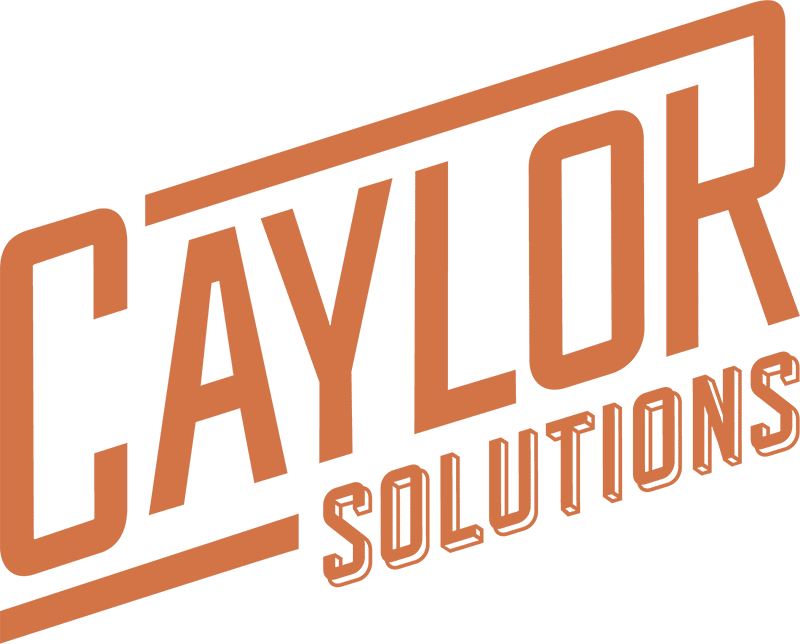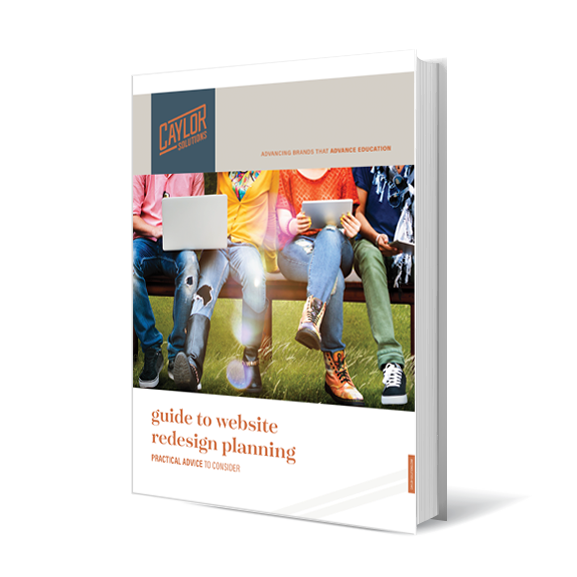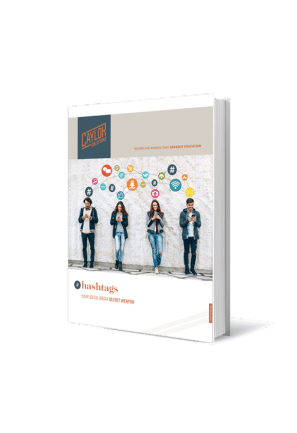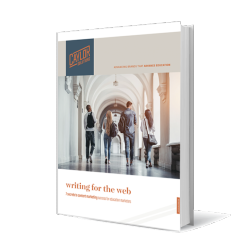Live chat windows – from providers like Olark, Hubspot, SnapEngage and others – have become a common part of the experience of visiting websites. What could this functionality do for your enrollment website?
If you’re not familiar, here’s a quick definition:
Live chat is instant access to a live representative through a chat window that pops up on the user’s screen. This is distinct from chatbots, artificial intelligence programs that “converse” with users.
Before we get into this solution, let’s address the issue: conversion.
Many Enrollment Websites Don’t Convert Like They Should
Every concern you have about your enrollment website, from speed to organization to content quality, ultimately comes down to conversion.
How successful are you at getting visitors to do what you want?
How frequently do visitors take action? The action might be:
- Fill out an RFI form or contact form.
- Subscribe to an email list.
- Download a resource.
- Schedule a visit.
- Sign up for an event.
Whatever it is, this is your KPI (key performance indicator). This is the measure of how well your website is doing its job, which in the modern era goes beyond providing information.
Your enrollment website’s job is to be a conversion machine.
But if yours is like most, it isn’t doing its job as well as it should be. According to Unbounce, the struggle with conversion is common in education:
- The median baseline conversion rate of education landing pages is 4.5%.
- In the higher education sub-category, the rate drops to 3.6%.
- For comparison, best-in-class landing pages convert at 27%.
Furthermore, SnapEngage found in the data that about 42 percent of higher ed marketers report they oversee at least one page that converts at less than 1.1 percent, resulting in “1,734 missed opportunities on average.”
I’m not sure how to interpret that last missed opps figure, but whether it’s over 1,700 per year or a lifetime, the potential value of converting those visitors is huge. There may be ideal students in that group. Or parents and other influencers eager to connect with you.
The Solution: Live Chat Platforms (like Olark)
We’ve got to solve this problem. I’ll give you nine good reasons why live chat software can help. And I’ll share a little about why I’ve started recommending Olark, which I have found to be a simple, affordable option for higher ed clients.
1. Your prospects are comfortable with real-time, Web-enabled human interaction.
Today’s traditional-aged students are digital natives who are not only comfortable with digital interaction, they often prefer it.
At the same time, they expect you to leverage the power of technology to cater to their individual needs. One-size-fits-all messaging (i.e. text on a website) isn’t enough.
They don’t see the Internet the way older generations do. It isn’t a digital update of old-fashioned one-way communication. To them, the Web’s primary purpose – besides delivering entertainment – is to enable instant two-way communication.
Gen Z have a strong sense of individualism. They want to be treated as individuals, through the digital media they’ve grown up with. Live chat checks those boxes.
With software like Olark, you can combine automation with that human touch to create this experience for every visitor who wants it:
- Greet automatically. (Jennifer: “Welcome! Is there anything I can help you with?”)
- Gather context. (“What kind of help do you need?” [Present options.])
- Handoff to a real person. (“Just a sec …” [Notify the real Jennifer to take over.])
2. Live chat cuts through the clutter of information.
In addition to the mountains of mail, endless email and ads from higher ed institutions your prospects receive, the websites they visit often feel like information overload.
You may have thought carefully through the user experience. Your website may be laid out beautifully, organized perfectly. But there’s no getting around the fact that you have an awful lot to say. Why? Because they have an awful lot of questions to be answered.
It’s just not possible to know precisely what information to prioritize without input from the user. Do you lead with student life facts? Financial aid resources? Mission and values? Whatever that perfect selling point is, there’s always a risk your prospect will miss it.
A certain degree of clutter (in the eye of the beholder) is inevitable.
Getting lost in it is not.
The key is to have a guide, a navigator on hand who can steer the prospect through the information to what really matters to them. That’s what live chat can do.
3. Your website will facilitate conversations rather than soliciting them.
If I were to press your admissions counselors on the number one action you want your website visitors to take, my guess would be this: they simply want a conversation.
Every measurable action – forms, requests, event attendance, etc. – is about creating an opportunity for conversation. Relationship building.
What if you didn’t have to wait to start building that relationship?
What if you could do it right here, at the point of entry?
I’m not advocating for you to get pushy with live chat. You’ll seriously creep out your prospects if you approach them aggressively, like a stereotypical used car salesman.
What I am saying is that being available for those who want to connect with a real person at this stage could make all the difference. If they want to reach out via chat, you have an amazing opportunity to be warm, answer questions and personally invite them to stay in touch.
That will put your relationship light years beyond being a name in a directory. It creates an opportunity to add someone to your contact list, which is an awesome conversion metric in and of itself!
4. Live chat may help reduce form abandonment.
According to Hanover Research, as of 2014, up to 31 percent of applicants to four-year college programs do not complete their online application after starting the process.
Considering the overall trend of online form or “cart” abandonment has only trended upward over the last decade, it’s safe to assume there is still room for improvement in reducing form abandonment in higher ed.
I’d encourage you to track your own data on this; however, more important than how many are failing to complete forms is the question of why?
There are many reasons why people abandon forms, but here are a few I think are especially relevant to higher ed:
- 67% of users will abandon forms “forever” if they encounter any complications.
- 9% of users abandon forms due to the process being too “long and confusing.”
- 17% don’t complete forms because they’re only conducting research and don’t want to commit.
What all this points back to is something that seems pretty obvious in retrospect. Applicants, like any other type of customer, won’t abide being unable to fill out a form or being unsure whether they should. The only way to ensure their concerns are addressed is with immediate support.
If you think of live chat as an intervention at the point of sale, it becomes an absolute no-brainer.
With a platform like Olark, all it takes is a click for them to say, “I’m having trouble with the form,” and you’re there to take care of them. (Or, at the very least, you can automate an immediate away message and a promise to contact them ASAP.)
5. Olark enables quick intervention for lower-income students.
The lack of awareness of financial aid options is one of the greatest obstacles to converting prospects to applicants.
You may think your messaging about tuition discounts, scholarships and borrower support is extensive, but many students will fixate on what they see in your tuition table. Personalized aid offers clarify this, but often come after these students have decided you’re too expensive.
As Jeffrey Selingo explained in the Atlantic a few years ago:
“In recent years, efforts to expand access to higher education have focused on making it more affordable. Colleges have added to their financial-aid budgets and offered larger discounts off tuition prices. But simply adding more money to financial aid is not the answer to recruiting more low-income students because those offers usually come too late in the college-search process, typically after the admissions decision. That’s why many low-income students never even apply to college, scared off by high tuition prices and a lack of understanding of the financial-aid process.”
One simple solution, at least for the students who are willing to ask, is to provide a method for them to reach out about their concerns instantly, on the same page as the application.
Imagine how many more low-income students you might be able to enroll had they been able to click on the chat box and ask, “Do you offer tuition discounts or anything?”
Or how many interventions you could do if starting the application process automatically triggered a financial aid-oriented prompt, like, “Do you need help paying for college? Ask me about that!” Olark enables triggered messages like this.
I can’t stress this enough: the more you enable two-way communication on your website, the fewer prospects will slip through the cracks.
6. Transcriptions help improve your website.
One of the takeaways from Olark’s compelling University of Montana case study is the way chat transcripts created a feedback loop that improved website content.
Chat queries are yet another source of FAQs. These are the bread-and-butter of content development; relevant, recurring questions (should) represent content priorities.
For U of M, website edits resulting from this information led to a 50 percent decrease in the number of chats coming in.
In other words, chats provide aggregate user input that help answer the elusive question, “How should we structure our content?” When well-structured, more prospects find answers themselves, reducing the workload on your team.
No complex, separate data-mining program is necessary, either. Olark makes it pretty easy to search for terms, sort queries by category and filter results.
7. Chat gives you another opportunity to make a brand impression.
Part of this benefit is about reinforcing brand imagery. You can customize live chat in Olark with colors that match your brand standards.
But in marketing, we know an authentic brand is about more than a color scheme. It’s about your personality. You can do a lot to communicate that in live chat, too.
- The admission counselor’s profile pic (avatar) can appear next to the text.
- Text is customizable to communicate a warm, inviting tone.
- Chat is an opportunity to utilize slogans and taglines as well (either sincerely or in a tongue-in-cheek, intentionally corny way).
8. Olark can aid with international student recruitment.
If your school depends on a heavy influx of international students, you may be interested in one of Olark’s “power-ups” (add-on features): translation.
The sweetest sound in any language to anyone is their name. The second sweetest sound is everything else – in their own language. To be able to speak your prospect’s language through a dependable translation platform is invaluable.
9. A chat platform like Olark provides a powerful admissions team management tool.
Whether you’re in a management role whose opportunities to monitor team performance are limited, or an enrollment marketer who’s never in the room or on the call with prospects, this aspect of live chat should be attractive.
Not only can you see which counselor handled each query, you can also read transcripts and get real-time activity reports that are powerful assessment tools.
The key here isn’t the technology itself. That’s just the gateway. What really matters is the human element. Are your counselors comfortable in this medium? Are they skilled at communicating tone through text?
These are skills not everyone will have right off the bat. But they can definitely be honed.
Whether you decide to try Olark or another platform you like better, now is the time to give live chat a try.
Here’s the deal.
I like Olark because it’s only $12/month per agent (counselor), it’s fairly simple, and it has the basic features I know a lot of my clients could really benefit from.
If you find another platform with more attractive features, more advanced functionality, go for it!
Let’s not get hung up with the details. What matters is adopting all the tools at your disposal – and within your budget – to connect with prospects who are slipping off your radar today.
Live chat is definitely one of those tools.
What do you think? Let’s chat about it. Either click the link above, or if you’re reading this on my website, click the bubble that says “Talk to Me” below. Ready if you are.
Looking for Enrollment Marketing Content that Works?
You’re in luck! We’ve curated 25 awesome ideas inspired by top higher ed institutions across the country and put them in one handy guide: 25 Ideas for Great Admissions Content.

-
- 25 enrollment marketing content ideas you might never have considered before
- Guidance on how to use each one for best results
- Brief discussion on why they work to help you sell these ideas to your team
Get inspired.
Get enrollment results.
Get 25 Ideas for Great Admissions Content.
Download your copy today!
Featured image by terovesalainen via Adobe Stock












